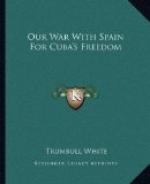“’The stars
Are elder scripture, writ
of God’s own hand,
Scripture authentic, uncorrupt
by man.’
“An interesting phenomenon sometimes occurs here, as in other islands of the West Indies, which was long supposed to be seen only in the eastern hemisphere. A short time before sunrise or sunset, a flush of strong, white light, like that of the Aurora Borealis, extends from the horizon a considerable way up the zenith, and so resembles the dawn as to prove greatly deceptive to a stranger. As he watches the luminous track he sees it decrease instead of becoming more vivid, and at length totally disappear, leaving the heavens nearly as dark as previous to its appearance. This is the zodiacal light.”
CHAPTER VII.
Wealth from nature’s stores in the forests and fields of Cuba.
The Palm Tree, the Queen of the Cuban Forests—Sugar Cane and Its Cultivation—The Tobacco Industry—Tropical Fruits and Flowers— Beauties of a Garden in Cuba—Enormous Shipments to Spain—The Wealth of the Island.
The forests of Cuba are of vast extent, and so dense as to be almost impenetrable. It is estimated that of about 20,000,000 acres of land still remaining perfectly wild and uncultivated, nearly 13,000,000 are uncleared forest. Mahogany and other hard woods, such as the Cuban ebony, cedar, and granadilla, valuable for manufactures, cabinet work and ship building are indigenous, and are exported to a considerable extent.
The palm is the queen of the Cuban forests and is its most valuable tree. It grows in every part of the island, but especially in the west, giving at once character and beauty to the scenery. The royal palm is the most common variety, and frequently grows to a height of one hundred and twenty feet, the branches numbering from twenty to twenty-five, in the center of which are the hearts or buds of the plant, elevating themselves perpendicularly with needle-like points.
This heart, enveloped in wrappers of tender white leaves, makes a most delicious salad, and it is also boiled, like cauliflower, and served with a delicate white sauce. The trunk of the palm is composed of fibrous matter, which is stripped off and dried, forming a narrow, thin board, which the natives use for the walls of their cottages. The boughs are sometimes made to serve for roofing, though palm leaves are usually used for this purpose, as well as for the linings of the walls. “El yarey” is another variety of the palm tree that is of great utility. From it the native women make the palm leaf hats that are worn by almost all the villagers and country people of Cuba.
Tropical fruits in abundance.
The fruits of Cuba are those common to the tropics. Bananas, pineapples, oranges, lemons and bread-fruit all grow in abundance, delicious to the taste and delightful to the eye.




